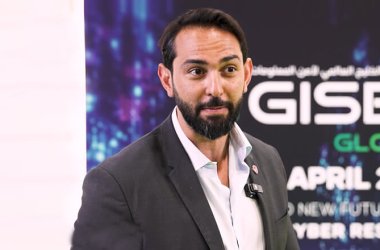
Patrick Ramseyer, VP EMEA at LinkShadow, discusses the growth of AI, their commitment to advanced analytics the secret to a successful digital transformation journey ahead of GITEX 2023.
Can you outline to our readers how your company has harnessed cutting-edge technologies to transform how you conduct your day-to-day operations to deliver the ‘experience’ that your customers, end-users, and partners’ demand in the experience economy?
Linkshadow has harnessed cutting-edge technologies to revolutionise its day-to-day operations and deliver exceptional experiences to its customers, end-users, and partners in the experience economy. Here’s how:
Advanced Analytics: Linkshadow utilises advanced analytics tools and techniques to gather and analyse vast amounts of data. This enables them to gain valuable insights into customer behaviour, preferences, and trends. By understanding their customers better, Linkshadow can tailor their products and services to meet their specific needs, providing a personalised and enhanced experience.
Artificial Intelligence (AI) and Machine Learning (ML): LinkShadow leverages AI and ML technologies to automate and optimise various aspects of their operations. For example, they use AI-powered chatbots to provide quick and accurate customer support, reducing response times and improving customer satisfaction. ML algorithms are also employed to enhance cybersecurity measures, detecting, and mitigating potential threats in real-time.
Cloud Computing: LinkShadow has embraced cloud computing to improve scalability, flexibility, and accessibility. By leveraging cloud infrastructure, they can easily scale their operations to meet growing demands and provide uninterrupted services to their customers. Cloud-based platforms also enable seamless collaboration with partners and end-users, enhancing overall efficiency and productivity.
By harnessing these cutting-edge technologies, LinkShadow has transformed its day-to-day operations to deliver the experiences that customers, end-users, and partners demand in the experience economy. They can provide personalised and tailored solutions, improve efficiency and productivity, enhance security and transparency, and create immersive and interactive experiences. This positions LinkShadow as a leader in the cybersecurity industry, driving customer satisfaction and loyalty.
OpenAI and ChatGPT are all the rage, and these new AI integrations have been tipped to fundamentally reshape all major industries as we know them. What is your view on OpenAI, are you excited by the new opportunities that it will present, or do you think more regulation is needed to control its impact on society?
Yes, I agree with your statement. The positive opportunities presented by Open AI are vast and yes, I am excited to see how this will evolve over the coming months and years. It is already well documented that these systems can be used for malicious purposes, e.g. using the technology to scan the dark web to accumulate knowledge on how to hack a particular customer, we are not that far away from having the ability to just punch in the question “tell me how to hack into my country’s central bank and provide me all the codes and methods that I will need”. The system will punch out detailed instructions on how to do it. In relation to Regulation, well, in my opinion the jury is out on that one. That’s like saying that “we need to regulate the internet”. It is truly a double-edged sword and personally I don’t believe it can be done if you have bad actors in the game. Maybe a form of AI usage license will be required, but where there is good, there is bad, and we all need to prepare ourselves with all the tools available and at our disposal to protect ourselves against Automated Threats and Attacks. The only way to do it is to quote the old adage, ‘Fight Fire with Fire’. Use AI to Fight AI – that is our approach at LinkShadow.
There has been a swathe of digital and cloud transformation projects in the Middle East over the last 3-5 years. However, many have struggled with the demands of cloud transformation, especially legacy-heavy players. What are the key processes that enterprises need to adopt to ensure a successful transformation journey.
Being from the cybersecurity sector we are very familiar with many of the challenges faced by enterprises when embarking on this Journey. Obviously, Data Security and Governance is a major consideration which is why we are heavily involved from an early stage. If I were to stick my neck out and recommend a few processes, then I would summarise them as follows.
- Develop a clear Strategy and Plan your business objectives.
- Involve key stakeholders from Day 1, including business leaders, IT Leaders, and Users
- Do a complete assessment of your” cloud” readiness to identify potential challenges.
- Check if your current Applications can be migrated to the cloud as-is, and which ones need to be modernised or rearchitected. This process involves assessing the feasibility of cloud migration, identifying dependencies, and considering factors like security, scalability, and performance.
- Establish robust data management and governance practices to ensure the security, privacy, and compliance of your data in the cloud.
- Prioritise security and compliance throughout the digital and cloud transformation journey. This includes implementing strong security measures, such as encryption, multi-factor authentication, and intrusion detection systems, as well as ensuring compliance with industry regulations and standards.
- Invest in change management practices to prepare employees for these changes, provide training and support, and address any resistance or concerns.
- Establish processes for continuous monitoring and optimisation. This involves regularly assessing performance, cost, and security metrics, and making necessary adjustments to optimize the cloud environment.
In your expert opinion, what do you view as the biggest problem facing enterprises in the IT and technology industry across the Middle East?
That’s easy – Security Threats and Skills Shortages. The cyber threat landscape is well known. I don’t have to elaborate on that, but globally there are shortages of over 3.5 million people in the cybersecurity sector alone, so it is not just an issue in the Middle East, it is a global phenomenon.
This supplement is titled Tech Vision, so with that in mind, what do you think the future holds for the IT and tech sector across the Middle East, what will be the key trends and technologies that will champion change over the next ‘digital decade’?
One thing that I love about living in the Middle East is the way our visionary leaders set their visions and make them their goals. Look at the plans for Dubai city over the next decade, the Saudi Vision 30 and so on, there are many examples. So, I suppose it is only natural that I would get asked a question like this. Personally, I feel there are several landscapes that will develop over the coming few years. Cloud computing will become the norm. We will see massive growth in the use of AI in our daily lives. The Middle East has been one of the model regions for the adoption of IOT. This is set to increase in my opinion. Cybersecurity will continue to be a top priority to prevent disruption in a digitised economy. The ME has always been a frontrunner in the adoption of new connectivity technologies. This to me is inspiring. So 5G and other connection technologies will continue to evolve and get better, faster.
Overall, the Middle East is poised for significant growth and innovation in the IT and tech sector over the next digital decade. The adoption of cloud computing, AI, IoT, cybersecurity, blockchain, 5G, and digital transformation initiatives will drive this transformation and create new opportunities for businesses and individuals in the region.





